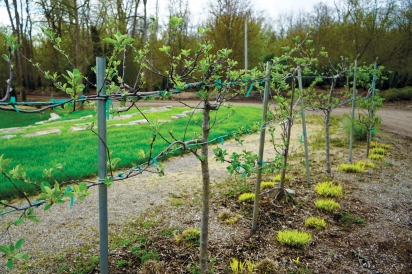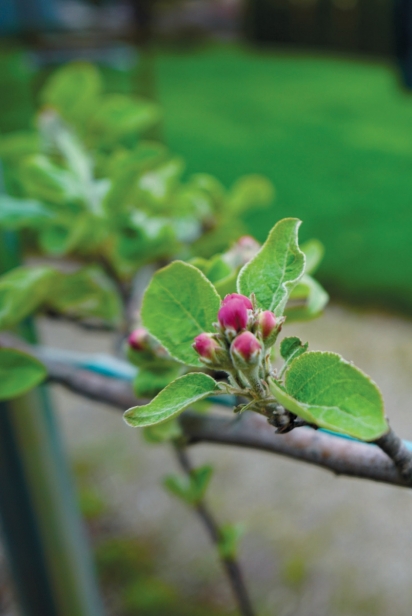Growing Up
For gardeners looking to maximize limited space, one direction is often overlooked: up.
But step into the Delta Terminal at Detroit Metropolitan Airport on your next sojourn out of Michigan and you’ll be greeted by a green wonder—on the wall. That’s right, the terminal is home to a living wall that represents one form of an emerging trend in gardening that takes full advantage of vertical spaces.
Vertical gardening has gained popularity in recent years as a way to create greenery in unconventional places. But the idea is far from new. Vines—especially grapevines—originated in Mediterranean cultures thousands of years ago, and have been a staple of food cultivation and landscape design for centuries. And the Hanging Gardens of Babylon, believed to date back to 600 BC, were the first vertical planting systems with irrigation mentioned in the historical record.
Today, vertical gardens are used for everything from small-scale ornamental and herb gardening, to outdoor landscape features, to indoor urban agriculture, to high-end interior design. They may go by a variety of names: living wall, vertical garden, green wall, stacked planters. What they have in common is a vertical structure that economizes on space.
According to Tim Travis, president of Goldner Walsh Greenhouse & Garden Center in Pontiac, vertical gardening can take many forms and achieve a variety of goals. The trick for doing it well, in Michigan, he says, is being realistic about the basics: climate, light, soil, water.
“In Michigan, it’s a little challenging because it just gets too cold,” says Travis.
That means year-round vertical gardens are not feasible in outdoor settings in Michigan. However, Travis notes that vertical systems can add beauty and additional productivity to outdoor spaces for part of the year, and with careful management can lend winter beauty as well. A variety of approaches, including cement and plastic modular wall systems, many of which are sold in kits, can work well in Michigan with a little extra care, he says.
“It’s a small amount of soil in those containers,” says Travis. “So they can usually tolerate a lot of smaller vegetables like hot peppers or plants that like hot temperatures. And the herbs can take the heat. If you have a sunny wall, it gets very, very hot.”
Maintaining a consistent water supply is absolutely critical, he says, as is avoiding plants like tomatoes that require copious amounts of hydration. Drip irrigation and gutter systems work well in vertical systems, he says.
For those looking to add year-round greenery inside, vertical gardens offer a compelling option. Such indoor systems must be designed with extreme care to avoid water damage and pest infestations.
But the results can be captivating. Travis recommends a variety of tropical plants for use in indoor garden walls. Species that are adapted to growing on trees in the tropical forest, like ferns and bromeliads, are highly recommended for use in indoor vertical systems.
While Travis notes that customers appreciate the drama and texture of cacti and sedum, and often look to incorporate them in vertical gardens, he does not always recommend them. Because they are not adapted to growing in vertical environments, they are less desirable. But vertical systems can be built to accommodate them.
“I’ve seen situations where you have a box and you plant a bunch of sedums in it,” says Travis. “It’s really cool looking, and you hang it on the wall and then you take it off the wall and you water it.”
Indoor systems require a great deal of planning, care and maintenance, Travis notes.
“It’s not a one-time thing and then you’re done. You have to stay on top of it,” he says.
Other less-intensive options include Tillandsia (or air plants), which require humidity and a light misting, and combination systems that integrate dried materials with low-maintenance plants.
For those interested in establishing outdoor vertical gardens in Michigan that are a bit more practical and less resource- and labor-intensive, Travis harkens back to the ancient Romans, the inventors of the espalier.
An espalier is a woody tree or shrub whose branches are trained to grow flat—either up against a wall or other support. For Travis, it’s a perfect marriage of form and function.
“Whether it’s an apple or a pear or apricot, you can pretty much espalier anything,” he says. “The Romans originally used them for practicality, to utilize small and narrow spaces.”
Espaliers can create living walls and fences in outdoor spaces that lend beauty, structure and function to gardens. Because they are often composed of fruit trees, they flower in spring and create waves of color which then give way to food production in the late summer and early fall. Travis has two espaliers on display at Goldner Walsh in Pontiac but often sources them for customers from Oregon and Washington.
Travis notes that he sees few espaliers in the landscape these days, and believes it’s because most people don’t know about them.
“People don’t know until we tell them about it, then they want it,” he says. “But when they see it, it’s a perfect accent to a blank garage wall or as some other feature, or as a living fence along a path.”
Indeed, according to Travis, espaliers can be a form of vertical art as well as greenery.
“The fun thing about espaliers is you can do any form you want. It can look like a candelabra. You can even form it to be your initials if you want or your logo or whatever,” he says. “They need to be pruned heavily, so a couple of times a year or one time a year at minimum. But it’s super, super easy.”







